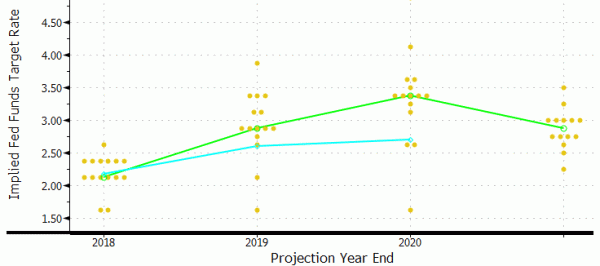- Fed hikes policy rate by 25 bps to 1.5%-1.75%
- Economic outlook has strengthened, despite setback in Q1 2018
- More confidence in hitting dual mandate
- Median FOMC rate projection rose in 2019, 2020 and long run
- Muted market reaction; odds of 4 rate hikes this year increased
The Fed hiked its policy rate as widely anticipated by 25 bps from 1.25%‐1.50% to 1.50%‐1.75% at Jerome Powell’s inaugural meeting as Fed governor. In its statement, the Fed admitted that growth moderated at the start of the year coming from a very strong Q4 2017. Looking forward though, the FOMC says that the economic outlook has strengthened. The US economy benefits from accelerating global growth and domestic fiscal policy changed from head wind into tail wind. This economic optimism translates in upward revisions to GDP forecasts for this year (2.7% from 2.5%) and next year (2.4% from 2.1%). The 2020 GDP projection remains unchanged at 2%.
The FOMC upgraded its assessment of the labour market. Job gains have been strong in recent months and the unemployment rate has stayed low. New forecasts indicate that the central bank thinks there is room for a further decline in the unemployment rate to 3.8% in 2018 (from 3.9%), and 3.6% in both 2019 & 2020 (from 3.9% and 4% respectively). The FOMC lowered its forecast for the NAIRU from 4.6% to 4.5%.
The appraisal of the US central bank’s other policy goal, price stability, remained broadly unchanged. In January, the FOMC expected inflation to move up “this year” and to stabilize around the Committee’s 2% objective in the medium term. The wording in the statement slightly changed to move up “in coming months” before stabilizing. PCE inflation forecasts remained unchanged in 2018 (1.9%) and 2019 (2%). The FOMC increased the 2020 forecast from 2% to 2.1%.
Upward shift dot plot, close call in 2018
The more upbeat economic assessment and increased confidence in hitting its dual mandate of maximum employment and price stability triggered changes in the FOMC’s dot plot which is used as a benchmark for the US central banks’ expected rate path. The new median forecast suggests 2 more rate hikes this year (to 2%‐2.25%), 3 hikes in 2019 (to2.75%‐3%) and 2 hikes in 2020 (to 3.25%‐3.5%). This scenario includes 1 additional hike in 2019 and 2020 compared with the December 2017 dots.
However, there’s more to the picture than meets the eye. The median forecast for this year remained unchanged, but the average projection increased by 0.17%! Six out of 15 governors expect 2 more hikes this year (only 2 more dovish dots), whereas six others pencil in 3 more hikes. Three months ago, this balance was still clearly tilted to the “cautious” side with a 6‐3 split (out of 16; with 6 more dovish dots). More specifically, it now takes only one Fed governor to change his mind in order to trigger an increase in the median forecast for this year. This probably helps explain why the market implied probability of 3 more rate hikes this year hardly changed compared to before the FOMC meeting (37% from 38%). The market attaches an 80% probability to a new 25 bps rate hike in June, also unchanged from before the meeting.
Finally, we take note of the increase in the Fed’s median forecast for the long term neutral, equilibrium rate, from 2.75% to 2.875%. Fed governor Powell at the press conference suggested that Fed participants believed that higher investment and productivity could be among the benefits from the new fiscal policy. This reasoning suggests that a further increase in the median forecast for the neutral rate is possible at one of the next FOMC meetings, especially as the situation is comparable with the 2018 dots. Only one governor needs to increase his projection to 3% to lift the median as well. That would be a break with history as the estimation of the neutral rate was almost consistently downgraded from 4.25% in March 2012 to 2.75% at the final two meetings of 2017. A higher neutral rate could flag a new sell‐off at the long end of the US yield curve in the MT
New Fed dot plot (green) and Fed Funds future curve (blue): increase of 2019, 2020 and LT median projections
Overall, we conclude that the Fed’s statement and dot plot turned more hawkish compared to December 2017. The unchanged forecast for this year and (limited) increase in the neutral rate, even if they were close calls, suggest that some FOMC members want more economic evidence that the central bank will reach its dual mandate. We keep our forecast for 4 rate hikes this year unchanged. Marvin Goodfriend will probably attend the June policy meeting, filling one of the vacant Washington‐based governors’ seat. His vote can already be enough to tilt the balance.
A final takeaway from Powell’s first press conference is that it seems that he will– more than his predecessors – actually try to be data dependent. Two months of good/bad eco data could have implications in both directions. Q2 eco data and the June policy meeting will show whether this hunch proved to be right or wrong
Dollar and yields correct slightly lower
Yesterday’s muted market reaction suggests that investors keep such scenario in the back of their heads. The US yield curve bull steepened with yields 4 bps (2‐yr) to 1.1 bp (30‐ yr) lower. The correction at the front end shouldn’t surprise given the huge front running we’ve witnessed this year. Additionally, some expected a 50 bps rate hike. The loss of interest rate support weighed on the dollar with EUR/USD rising from 1.2260 to 1.2340. The trade‐weighted dollar fell from 90.20 to 89.70. US stock markets trade volatile, but could live with the fact that the worst possible outcome (very hawkish Fed) was avoided. Main indices closed around 0.2% lower on a daily basis













